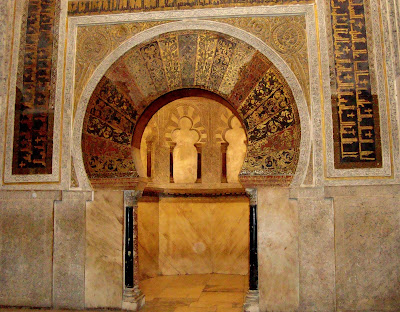 |
| Supposedly an illustration of an incident from the cycle of El Cid, which also comes from historical/epic tradition. |
I wanted to discuss the baddies of The Seven Noble Knights of Lara here. There are spoilers in the following comments.
The story on which I base The Seven Noble Knights of Lara contains historical figures, but the existence of Ruy Blásquez and Doña Lambra has not been verified, perhaps because no one, even today, would welcome the possibility of being associated with such vile traitors.
Ruy Blásquez –
a. k. a. Ruy Velásquez – doesn’t kill a king or even a count. But when he wipes
out seven warrior brothers in an epic battle and sends their father to be
beheaded, he eliminates an entire generation of soldiers of Castile, leaving himself
with all the power for more than ten years at the turn of the eleventh century.
The crime is all
the worse because the warriors are his nephews, the sons of his sister. There
are few stronger blood ties at this time in history. An uncle is expected to
take on an almost nurturing role, ensuring that his nephews realize their
potential, especially on the battlefield, and for this surrogate father to cut
the knights down in their prime frankly smacks of taboo. Further compounding the betrayal, Ruy
Blásquez uses an army of Moorish soldiers to take down his nephews and sends
their father to Córdoba, the capital of the Islamic caliphate. His close
association with powerful Muslims taints him in the eyes of his Christian
neighbors. His actions betray not only his blood relatives, but also the
Christian faith.
Although I tell
the story from many different points of view in my novel, Ruy Blásquez’s
actions are so hard to understand that I dared not take a seat behind his eyes.
The source material writers seem to have felt the same taboo. They make an
effort to distance the audience from Ruy Blásquez, referring to him as I do
here, always with his first and last names, and usually appending “that
traitor” or calling him simply “the traitor.” I took a more subtle route: I made
him a slippery character, hard to get a handle on in general, so that his
incomprehensibility in the betrayal is somewhat believable. The reader is left
to conjecture that his wife, Doña Lambra, made him do it.
Doña Lambra, on
the other hand, was too much fun not to try to understand. She’s frustrated
because she has to marry Ruy Blásquez and covets the nephews’ superior power.
She also feels an inconvenient level of sexual tension around her handsome new
nephews-in-law, and when they get into an argument and kill her cousin, she snaps. She
has to be a little insane to take such a disproportionate revenge, but she also
has to be manipulative or influential in order to get Ruy Blásquez to agree,
even if he is wishy-washy. It was delightful creating this dangerous beauty the
reader loves to hate.
Check back soon for more about how I developed these fascinating characters.


